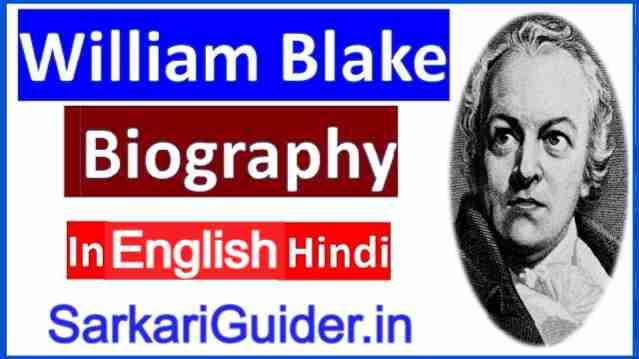William Blake Biography

William Blake
Life and Works –
William Blake was born in 1757 in London. His father was a hosier. He did not go to school, instead he was apprenticed to James Basire who was an engraver to the Society of Antiquaries, and then became a student at the Royal Academy. The bookseller J. Johnson took him under his employment as an engraver from 1779. He met Fuseli and Flaxman (the latter a follower of Swedenborg) in 1780, whose mysticism cast an everalsting influence on Blake. In 1782 he married the daughter of a market gardener. Catherine Boucher. Their issueless marital life was a happy one.
Flaxman introduced Blake to the intellectual circle of Revd. A.S. Mathew and his wife, and both Mathew and Flaxman financed the publication of Blake’s first volume, ‘Poetical sketches’ (1783). In 1784 Mrs. Mathew helped him set up a print shop at 27 Broad Street; at about the same period as his satirical poem ‘An Island in the Moon’ came out. ‘Songs of Innocence’ (1789) and ‘The Book of Thel, belong to the early phase of his highly distinctive mystic vision. Some years later in Jerusalem he stated through the character Los, “I must create a system, or be enslav’d by another man’s.”
The Marriage of Heaven and Hell (1790-93) is his principal prose-work which contains paradoxical aphorisms. His main revolutionary works include ‘The French Revolution’ (1791); ‘America : A Prophecy’ (1793); ‘Visions of the Daughters of Albion’ (1793), in which he develops his attitude of revolt against authority, combining political fervour and visionary ecstasy. He demonstrated his command of the lyric in ‘Songs of Experience’ (1794) which includes ‘Tyger! Tyger! burning bright’, ‘O Rose thou art Sick’ etc.
In 1790 Blake moved to London. There he continued to engrave his own works and to write, evolving his mythology further in the Book of Urizen (1794); Europe: A Prophecy (1794); The Song of Los (1795); The Book of Ahania (1795); The Book of Los (1795); and the Four Zoas (originally entitled Vala, written and revised (1797-1804). He also worked on Milton and Jerusalem : the Emanation of the Giant Albion. Being cheated by Cromek, he was disappointed. His last years were passed in obscurity, although he continued to attract the younger artists.
On his death, Blake was denounced as insane for praising. ‘The Naked Human form as divine’, and sexuality as the means whereby ‘The Soul Expands its Wing’, and elevating forgiveness above the ‘Moral Virtues’. He was, however, praised by Swinburne, Yeats, G. Keynes and was acclaimed by W.H. Auden as ‘Self-educated Blake……’. He died in 1827.
William Blake Biography in Hindi
हिन्दी साराँश –
विलियम ब्लेक का जन्म लन्दन में सन् 1757 में हुआ था। उसके पिता का होजरी का व्यवसाय था। वह स्कूल नहीं गया। स्कूल जाने के स्थान पर वह जेम्स बेसियर के साथ लगकर एनग्रेविंग का काम सीखने लगा। जिनका सोसायटी ऑव एण्टी क्वेरीज़ के लिए काम होता था। तत्पश्चात वह (ब्लेक) रायल अकादमी का छात्र बन गया। जे. जॉनसन नामक पुस्तक विक्रेता ने ब्लेक को अपने अधीन सेवा में ले लिया, इस प्रकार वह सन्1779 से एनग्रेवर का काम करने लगा। सन् 1780 में ब्लेक का परिचय फुसेली तथा फ्लैक्समन से हुआ। फ्लैक्समन स्वीडनवोर्ग का अनुयायी था जिसके रहस्यवादी चिन्तन से ब्लेक बहुत प्रभावित हुआ। सन् 1782 में ब्लेक ने कैथरीन बोचर से विवाह किया। इनका सन्तति विहीन वैवाहिक जीवन भी सुखद रहा।
फ्लैक्समन ने ब्लेक का परिचय ए.एस.मैथ्यू और उनकी पत्नी के बौद्धिक परिक्षेत्र से कराया। मैथ्यू और फ्लैक्समन दोनों ने मिलकर ब्लेक के प्रथम काव्य संग्रह ‘पोयेटिकल स्केचेज़ (1783) प्रकाशित कराया। सन् 1784 में श्रीमती मैथ्यू ने ब्लेक को 27 ब्रांड स्ट्रीट पर एक प्रकाशन संस्थान खुलवाया लगभग इसी समय ब्लेक की एक व्यंग कविता ‘चन्द्रमा का द्वीप’ प्रकाशित हुई। ‘भोलेपन के गीत’ (1789) तथा ‘थेल की किताब’ उसके रहस्यमयी चिन्तन की कवितायें हैं। कुछ वर्ष पश्चात उसके जेरुसलम में अपने एक चरित्र के माध्यम से ये भाव व्यक्त किये – या मैं स्वयं कोई मार्ग बनाऊँ या दूसरे के पथ का पथिक बनूँ”।
सन् 1790-93 के बीच लिखी गयी पुस्तक ‘स्वर्ग और नरक का आपसी विवाह” उसकी विरोधाभास युक्त गद्य रचना है। उसकी प्रमुख क्रान्तिकारी रचनायें हैं। ‘फ्रांस की क्रान्ति’ (1791), अमरीका- एक भविष्यवाणी (1793), अल्बियन की पुत्रियों की दृष्टियाँ (1793) इन सभी में वह अपने क्रान्तिकारी स्वरूप को प्रकट करता है। सन् (1794) में प्रकाशित “अनुभव के गीत” में उसने गीतिकाव्य पर अपने अधिकार का प्रदर्शन किया है। इसी काव्य संग्रह में उसकी ये प्रसिद्ध कवितायें संग्रहीत हैं – ‘टाइगर, टाइगर बर्निंग ब्राइट’ तथा ‘रोज दाउ आर्ट सिक’ आदि। सन् (1790) में ब्लेक लन्दन चला गया। वहाँ वह अपने स्वयं का एनग्रेविंग व्यवसाय चलाता और काव्य रचना भी करता था। उसकी प्रसिद्ध रचनायें हैं – बुक ऑव युरिजन (1794), योरोप – एक भविष्यवाणी (1794), दि सांग ऑव लोस (1795), दि बुक ऑव अहनिया (1795), दि बुक ऑव लोस (1795), दि फोर जोवाज़ (1797-1804)| ब्लेक ने “मिल्टन और जेरूसलेम – दि एमानेशन ऑव जाइन्ट अल्बियन” पर भी कार्य किया। क्रोमेक द्वारा ठगे जाने के कारण वह निराश हो गया। उसके अन्तिम वर्ष एकाकीपन में बीते, यद्यपि नौजवान कलाकार उसके पास मार्ग दर्शन हेतु आते रहते थे।
उसकी मृत्यु पर नग्नता और काम विषयक उसके क्रान्तिकारी विचारों के कारण अनेक लोगों ने पागल कहकर उसकी अप्रतिष्ठा की। फिर भी स्विनवर्ग, यीट्स और जी. केनीज ने उसकी प्रशंसा की है। डब्ल्यू एच. ऑडेन ने “स्वयं शिक्षित ब्लेक” कहकर उसकी प्रशंसा की है।
Important Links
Metaphysical Poetry: Definition, Characteristics and John Donne as a Metaphysical Poet
John Donne as a Metaphysical Poet
Shakespeare’s Sonnet 116: (explained in hindi)
What is poetry? What are its main characteristics?
Debate- Meaning, Advantage & Limitations of Debate
Sarojini Naidu (1879-1949) Biography, Quotes, & Poem Indian Weavers
Charles Mackay: Poems Sympathy, summary & Quotes – Biography
William Shakespeare – Quotes, Plays & Wife – Biography
Ralph Waldo Emerson – Poems, Quotes & Books- Biography
What is a lyric and what are its main forms?






